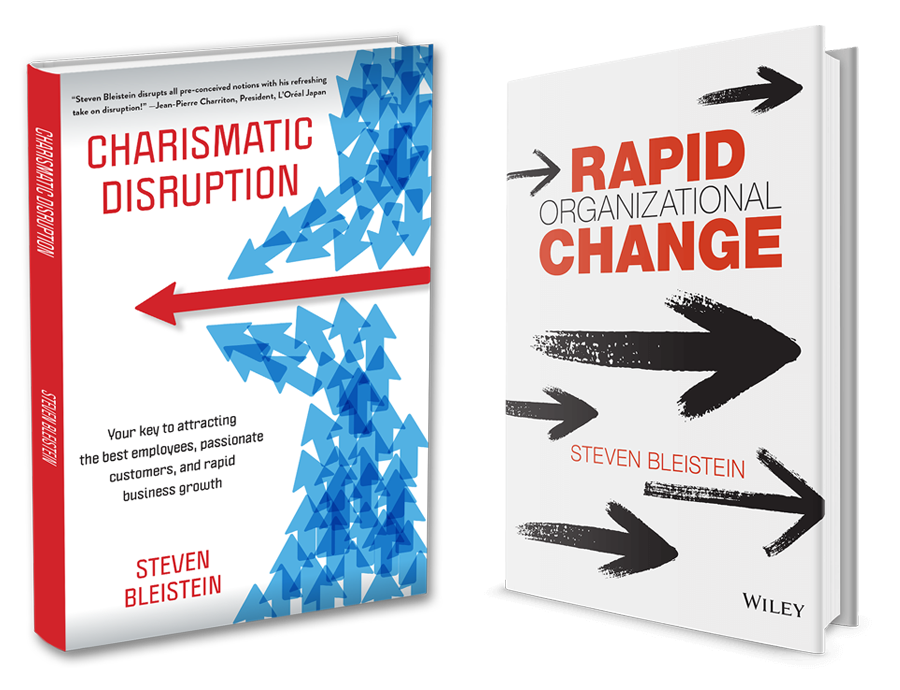CEOs often ask me how best to lead dramatic, strategic change knowing full well the kind of concerns, resistance, and doubt that such change can evoke in some staff. Below I list some of what advise.
- It is success that prompts need for dramatic strategic change, rarely failure. The CEO of a Japanese company seeking to radical transformation of his company’s long-held business model to one that will disrupt the industry and likely cause more than dismay among long-term customers asked me, “How can I explain the strategy we have had up to now had been wrong?” My answer? “You don’t have to. Your premise is wrong!” The need and desire for change was prompted by the company’s success. The strategy up to that point had worked! However, the old strategy no longer made sense to take the business to the next level, nor to adequately address new opportunities in the industry which had not existed before. Make sure your employees know that it is their success that prompts the need for change, not any failure, shortcoming, or mistake.
- Catering to your vanguard trumps appeasing your skeptics. In any dramatic change in an organization, some of your staff will be your vanguard, and on board from the start. Some will be naysayers, and will never be convinced no matter what you say or do. Most will be on the fence waiting to see which way the wind blows, either leaning skeptical but willing to be convinced or leaning cautiously optimistic hoping to see good results. The naysayers might be the most vocal, but ignore them. Appeasing the naysayers in hope to change their views only dampens your vanguard’s belief in your resolve. Some of your vanguard—the very people you want to retain—might even quit in frustration! People on the fence will begin to lean more skeptical. Ignore your naysayers and move forward fast, and you will ignite the enthusiasm of your vanguard. Those on the fence who are leaning optimistic will likely join them, because energy and enthusiasm is contagious. The leaning skeptical will see the way the wind is blowing and begin to lean optimistic. Some of the ardent naysayers will ultimately leave company of their own accord. Don’t hesitate to fire the rest after all else has been tried and failed.
- Dissent is a mark of a thinking adult. Never worry about people who disagree. It is alright that someone would have taken the business in a different direction from the one you chose, as long as they will back you in your decision. When they are leader, they can decide. It is alright for someone to believe there is a better way to achieve agreed upon ends, as long as they voice their ideas so everyone can consider them. Who knows? They might be right! Thinking adults will come to their own conclusions in their own time. Some will agree with your bold strategic change right away. Others will need the time to be convinced. I find few business practices more offensive than evangelism, where a leader attempts to convert everyone at the same time with fervor. Few things in business are more insulting than employing normative pressure of a crowd to evoke what is often feigned enthusiasm for an idea that many are still trying to grasp. If you want people to be on board with you and not just your idea, you need to make room for atheists in the tent.
- The right strategy takes you to the business you want, not to the business you think you can reasonably expect to have. The putative “right” strategy is an illusory concept. In most cases, a business has multiple options for strategy, most of which are good. At one client company of mine, the CEO asked me how to respond to questions about a strategy of selling directly to end-customers when the company has outstanding opportunity in expanding selling through distributors. The answer is only that both strategies are good, and the company could be successful at either, but not both. The direct-selling strategy is a choice, not an imperative.
- Contingencies for when your assumptions are wrong trump analysis for why your assumptions must be right. If you want to be convincing about soundness of your strategy, no matter how bold, talk about all the reasons you might be wrong and what you plan to do if that turns out to be the case. No strategic plan ever survives the first encounter with the market. Whether members of a board or staff in your company, it is the leader who has eyes wide-open to risk, and is prepared to take action to succeed, come what may, who inspires confidence. It is only the leader who expounds endlessly on the righteousness of a single playbook based on reams of meticulously analyzed data who others will doubt can deliver when a faulty assumption becomes apparent and the playbook no longer applies. It is contingencies that make a strategy robust.
- The best strategies require no slide presentation to explain. If your staff are unable to grasp your strategy with a few succinct sentences from you, no slide presentation will make it any easier to understand. Note here that I say “grasp,” not agree. Understanding and agreement are not the same, and as I mention above, dissent is a mark of a thinking adult.
- Bold strategy polarizes, at least at first. Weak strategy evokes only mild assent disguised as team unity. If a strategy you propose as leader causes people in your company to jump up and down shouting, “Well it’s about time!” and while others rail that this is the end of the business, then you are likely on to something good. It is only the strategy that everyone agrees is reasonable that is unlikely to produce anything other than mediocre results.
These are just some of the principles in my manifest for leading bold strategic change. What are yours?


